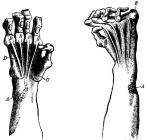 Related entry: Progressive Muscular Atrophy
Related entry: Progressive Muscular Atrophy
Synonyms.—Poliomyelitis Anterior Chronica; Wasting Palsy.
Definition.—A chronic degeneration of the motor tract and characterized by a progressive wasting of the muscles. The disease is one of adult life, and occurs generally between the age of thirty and fifty years. It affects males more frequently than females.
Etiology.—The cause is unknown, though quite a variety of causes have been mentioned by various writers, the most important being the following: Heredity, excessive muscular effort, exposure to cold, traumatic injuries of peripheral parts of the body, the infections fevers, typhoid fever, influenza, diphtheria, measles, rheumatism, etc., and excessive venery and masturbation.
Pathology.-—A slow degeneration of the ganglionic cells resulting in their partial or complete destruction. "The neuroglia is excessively developed," while the anterior nerve-roots passing from the horns are atrophied. There is an abnormal dilatation of the vessels of the cord, and sclerosis of the arterioles.
The muscles become shrunken and pale in color to the unaided eye, and the microscope "reveals a disappearance of the transverse striae in the fibrille," while fat connective tissues replace the muscular fiber in the advanced stage. "As to the relation of the nervous changes to the muscular atrophy, the conspicuous symptoms of the disease, there is more than one possible explanation. As in bulbar palsy, according to one view, the atrophy of the anterior cornua, is primary, the result of chronic poliomyelitis anterior, the degeneration of the peripheral nerves and muscles being secondary to it.
"According to another view, the muscular atrophy is primary, possibly due, as Friedreich sought to prove, to a myositis, followed by fatty metamorphosis of the sarcous substance and subsequent absorption of fat, or to a simple primary fatty meta-phorosis." (Tyson.)
Symptoms.—The disease comes on insidiously, the characteristic feature of which is the development of extensive and progressive atrophy of certain muscles. The disease generally begins in the upper extremities, though the lower may be involved first.
The patient's attention is called to the wasting of certain muscles, by the loss of power in the affected part, this being usually manifested in the hand and shoulder. Beginning with the short muscles of the thumb, there is soon flattening of the ball and the simultaneous wasting of the interossei results in depressions between the metacarpal bones. On account of a predominance of power in the extensors and abductors of the hand, the "ape-hand" becomes characteristic.
As progressive changes take place and the interossei become more affected, the hand assumes greater deformity and we have the "claw-hand." With atrophy of the lumbricales, there is flattening of the palms. From the hand the wasting attacks the muscles of the forearm and thence to the arm and shoulder. "In the forearm, the extensor muscles undergo atrophy more frequently than the flexors."
When the shoulder becomes involved, the deltoid becomes flattened and the movements of the arm are more or less impaired. The atrophy generally attacks the right hand before involving the left. With marked atrophy of the arms, the process extends to the muscles of the scapula and trunk.
Late in the disease, the muscles of the lower extremities become involved, the flexor muscles being the first to be attacked.
When the diaphragm undergoes atrophy—a rare case—respiration becomes greatly impaired.
In proportion to the wasting, the electrical excitability fails, faradic and galvanic diminishing together. The reflexes are generally lost, the knee-jerk remaining longest since the lower extremities are among the last to be involved.
 Fibrillary contractions are constant and characteristic symptoms. Sensation is not impaired, and the bladder and rectum are not involved.
Fibrillary contractions are constant and characteristic symptoms. Sensation is not impaired, and the bladder and rectum are not involved.
The disease is slow in its course, the patient frequently dying of some intercurrent disease, as pneumonia, tuberculosis, etc.
Diagnosis.—"Progressive muscular atrophy has to be distinguished from all other diseases accompanied by atrophy of muscles. The important feature is the slow commencement by atrophy and weakness together, without pain, spasm, or sensory troubles. This distinguishes it from tumor and meningitis, which may cause muscular atrophy. In acute poliomyelitis of children and adults, the history is completely different. In the typical cases of amyotrophic lateral sclerosis the course is more rapid, and the reflexes are early increased. When the atrophy affects the hand alone, the deformity resembles somewhat the result of lesion of the ulnar nerve; but in this last the ulnar half of the hand is more decidedly affected (the radial lumbricales being supplied by the media nerve), and anesthesia and trophic changes occur; in traumatic cases, the history of injury will, of course, help. Lead paralysis is recognized by the extensors being first, and generally alone, affected; by the blue line on the gum, the detection of lead in the urine, and perhaps by the occupation, and preceding attacks of colic. Multiple neuritis is distinguished by the rapid onset, the wide extent of the parts affected, the numbness of anesthesia, and the tenderness of the muscles. Pseudo-hypertrophic paralysis must be recognized by the enlargement of muscles, and its development in childhood; idiopathic muscular atrophy, by the atrophy beginning differently; e. g., in the face or legs." Taylor.
Prognosis.—This is unfavorable as to cure, though in rare cases the progress of the atrophy is arrested.
Treatment.—Medication has but little effect upon the progress of the disease. The patient's general health will be improved by the use of the bitter tonics and by hygienic and dietetic measures. Arsenic and strychnia have been extolled as influencing the diseased processes, though this is doubtful. Massage and electricity should be faithfully tried. When possible, the patient should seek an equable climate where he could be much in the open air- and sunshine, and free himself from mental worry. Gradually, but surely, however, the disease advances, finally resulting in death.
The Eclectic Practice of Medicine, 1907, was written by Rolla L. Thomas, M. S., M. D.

